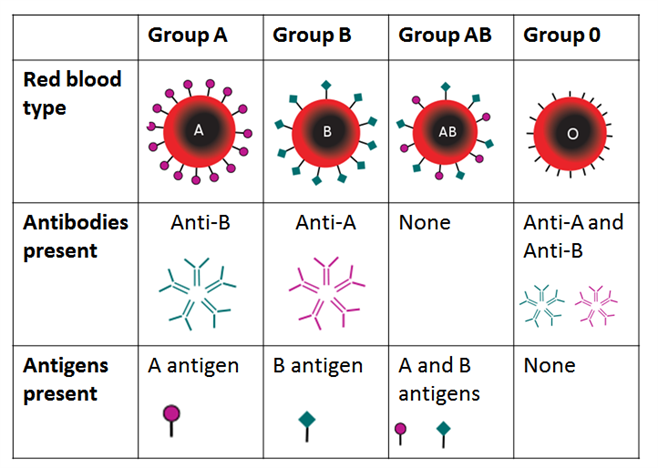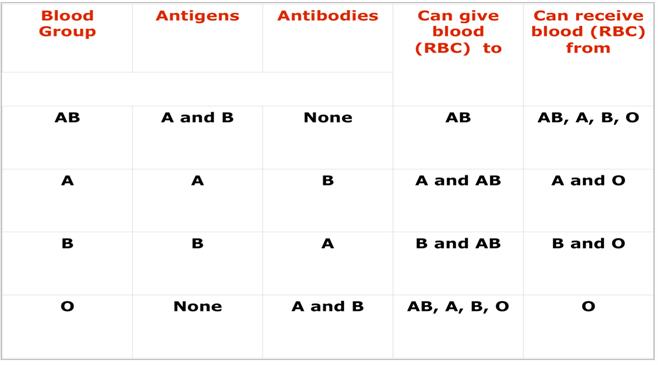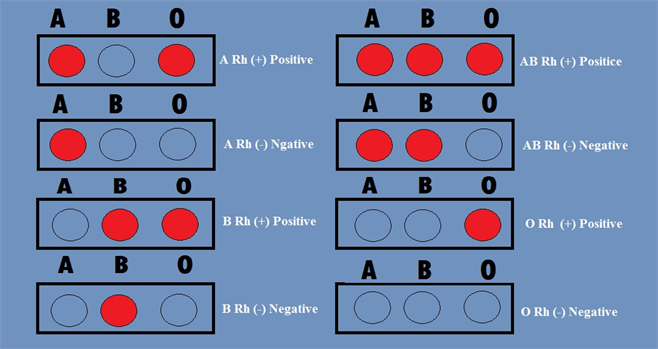PDF chapter test TRY NOW
Karl Landsteiner, in the year \(1900\), first identified the concept of ABO blood grouping. He identified three blood groups - \(A\), \(B\) and \(O\), while Decastello and Steini recognised the blood group \(AB\) in \(1902\).
The human blood contains antigens (Ag) or agglutinogens and antibodies (Ab) or agglutinins. Antigens are located on the membrane surface of the RBCs. In contrast, antibodies are found in the blood plasma.
Based on the presence or absence of antigen and antibodies, the human blood groups are classified into four groups - \(A\), \(B\), \(AB\) and \(O\). A person has one of the four blood groups:
1. \(A\) group individuals:
A person with blood group '\(A\)' has antigen \(A\) on the surface of RBC and antibody \(b\) (anti-\(b\)) in the blood plasma.
2. \(B\) group individuals:
A person with blood group '\(B\)' has antigen \(B\) on the surface of RBC and antibody a (anti-\(a\)) in the blood plasma.
3. \(AB\) group individuals:
A person with blood group '\(AB\)' has antigens \(A\) and \(B\) on the surface of RBC. Both the antibodies are absent in the plasma.
4. \(O\) group individuals:
A person with blood group \(O\) has no antigens on the surface of RBC. At the same time, the plasma contains both the antibodies \(a\) and \(b\) - anti \(a\) and anti \(b\).

Antigen and antibodies present in the different blood groups
Blood donation:
During a blood transfusion, antigen and antibody compatibility (matching) between the donor and the recipient (person receiving blood) must be considered. Agglutination (clumping) of blood occurs in the body when an individual receives a mismatched blood group from a donor, resulting in death.
People with blood group '\(AB\)' are known as "Universal Recipient" since they can receive blood from persons with any blood group. People with blood group '\(O\)' are known as "Universal Donor" since they can donate blood to persons with any blood group.

Distribution of Antigen (RBC) and Antibody (Plasma) in different blood groups
Rh factor:
Rh factor was discovered by Landsteiner and Wiener in \(1940\) in Rhesus monkey. Hence the name Rhesus factor. The surface of RBC contains the antigen for the Rh factor. \(Rh^+\) persons have Rh antigen on the membrane surface of RBC. In contrast, \(Rh^-\) persons do not have Rh antigen on the membrane surface of RBC.
Antibodies that develop against the \(Rh\) antigen is called \(Rh\) antibodies. The formation of Rh protein is controlled by a dominant gene called \(R\), and thus, \(Rh^+\) is dominant to \(Rh^-\). Both \(Rh^+\) and \(Rh^-\) are normal, and the problem arises during blood transfusion and pregnancy.

Blood grouping with Rh factor
A video displaying the different blood groups and why there is a blood transfusion?
Reference:
https://upload.wikimedia.org/wikipedia/commons/2/2c/Compatibility_testing_concerning_RBCs_2014-02-01_00-42.jpg
https://commons.wikimedia.org/wiki/File:%CE%9F%CE%BC%CE%AC%CE%B4%CE%B5%CF%82_%CE%91%CE%AF%CE%BC%CE%B1%CF%84%CE%BF%CF%82-_blood_types.png
https://commons.wikimedia.org/wiki/File:Blood_Group_Chart_Designed_by_((Sir_Ibrahim_Awwab))_29_July_2018.png
https://www.youtube.com/watch?v=lazxbXpsiWg
